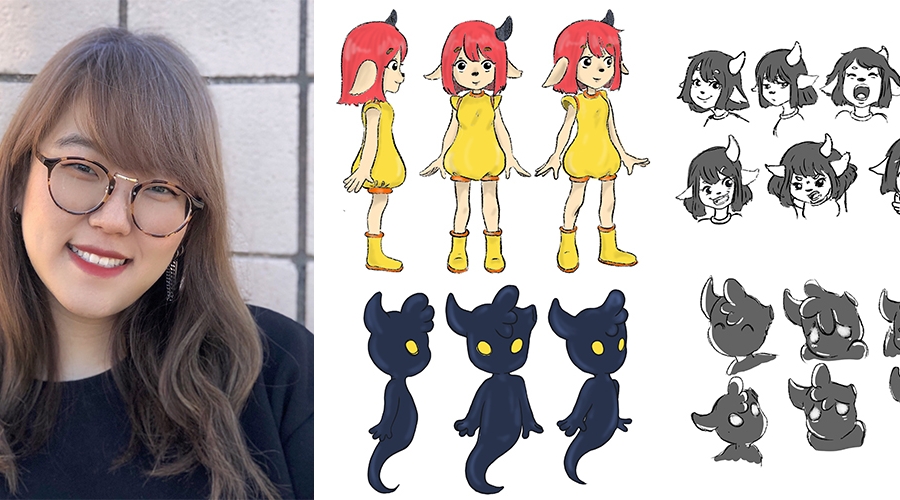
An abridged version of this profile appears in the 2021-2022 Admissions Viewbook. To request a Viewbook, please click here.
For Zione (pronounced “Zy-One”) Hong, cartoons weren’t just a means of childhood entertainment. As a deaf child growing up in Glendale, California, they opened up a world of imagination, but also the career path she’s currently pursuing as a recent Otis College graduate.
“I have loved watching Disney movies since I was little,” Hong says. “At the time, closed captions were not available, but I could understand the story through the characters’ animation and gestures. It made me want to make animation.”
Hong’s goal is to not only create deaf characters and storylines and use sign language in her work, but also to be a change agent for the industry and inspire other differently-abled artists and animators to create work that is inclusive and representative of all spectrums of life. “My passion as an animator is focusing on the importance of embracing our unique abilities while providing equal access and self-esteem for children, with an emphasis on deaf culture,” she says. “I want to share my animation stories with a global audience—hearing and deaf.”
In many ways, Hong was destined for Otis. Her father is a graphic designer who attended Parsons School of Design—which was affiliated with Otis from the 1970s through the ’90s—and her mother is an interior designer who graduated from Otis. “You put them together and you get an animator,” Hong jokes. Her father immigrated from South Korea when Hong was just a baby so that she would have better opportunities as a deaf child. He introduced her to those Disney films, as well as Japanese anime and manga, instilling in her a love for such filmmakers as Studio Ghibli cofounder Hayao Miyazaki (“He creates a world full of awe and wonderment,” she says). “I remember my dad would see how I would respond to the animation and he could see how I could connect. He knew somehow the profound impact it was having on me and so he always encouraged me. I think he knew a long time ago that I would be an animator.”
“I want to share my animation stories with a global audience—hearing and deaf.”
At Otis, Hong found support among her peers, faculty, and staff that enabled her to pursue her dreams. Dr. Carol Branch, Assistant Dean for Student Affairs and Otis’s Title IX Coordinator, helped create an accessible environment, which included a full-time sign-language interpreter. Hong also received help from the Student Learning Center tutor Justin Kahn. “Even though he has graduated, he still finds time to lend me his expertise and help me with feedback on my projects,” she says. Digital Media program Chair Harry Mott was also key to her success. “He is the best inspiration for me because he creates a department where he shows complete respect for each of his students and he will work to find the best solutions for any challenges.”
While a student, Hong sometimes used the help of her hearing team members to create films that would appeal to both hearing and deaf audiences. “I can also use the visual cues within the WAV files to see where different types of sounds begin and end to match them correctly on the timelines in Maya and other software,” she says. “I am able to add my dialogue or musical soundtracks to my animations, making me a more well-rounded animator and giving me additional job opportunities than limitations.”
Hong would love to work for a big animation studio like Pixar or Disney because of their global reach and renown, but also because she could make a big impact as a deaf animator in an industry that has a lot of catching up to do, not only in making content that is inclusive, but also in accommodating animators of all abilities. “By working at different studios they can learn from me, I’m an educational tool,” she says. “I believe I have been that at Otis as well, for individual instructors and all of the peers that I’ve had at school.
Facial expression and body language are integral parts of American Sign Language,” she continues. “Deaf people have an exceptional ability to use and read nonverbal communication. My animation stories are about people celebrating unique things; everyone is different and we need to respect each other equally through compassion.”
You can see more of Hong’s work at www.zionehong.wixsite.com/portfolio and her Instagram, @zioneh_art.
Press play below to watch a 2D animated film that Hong created while a student at Otis.
Main image, sketches, and video provided by Zione Hong.


